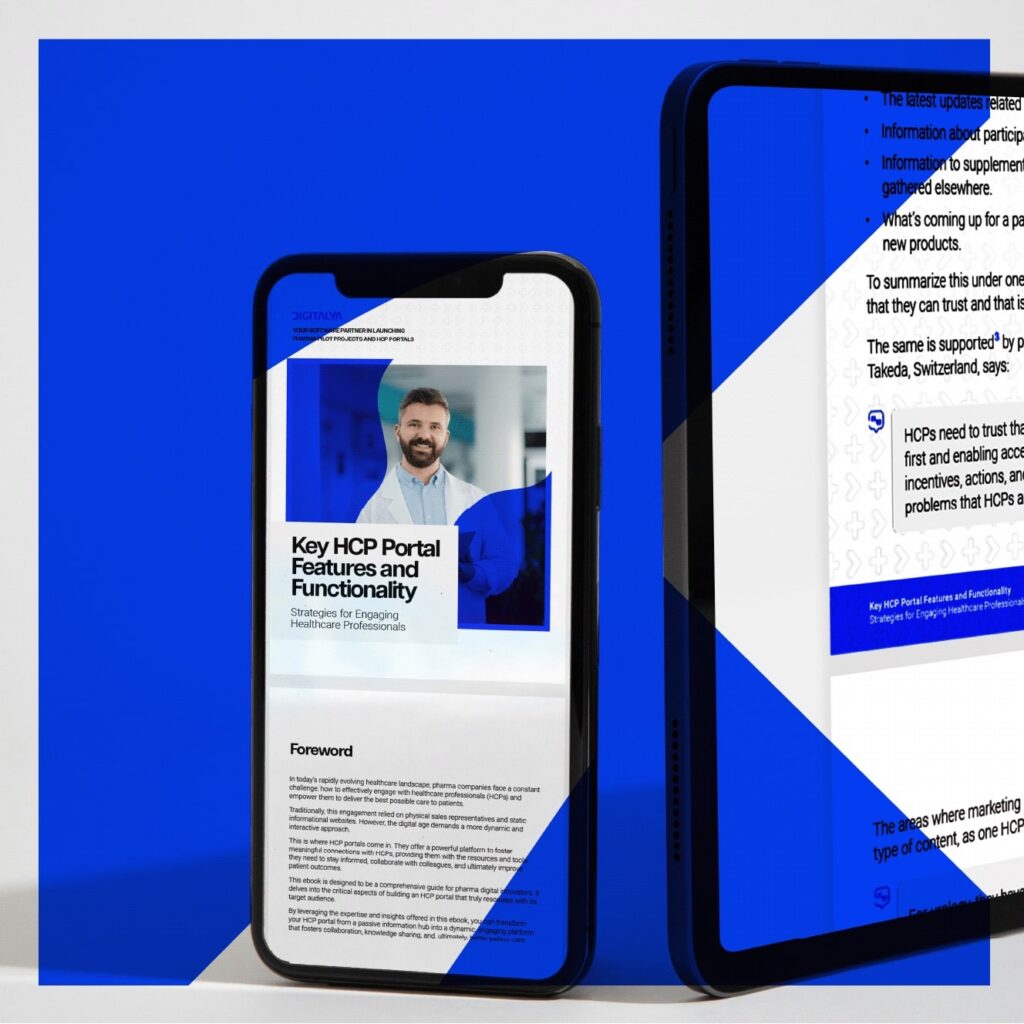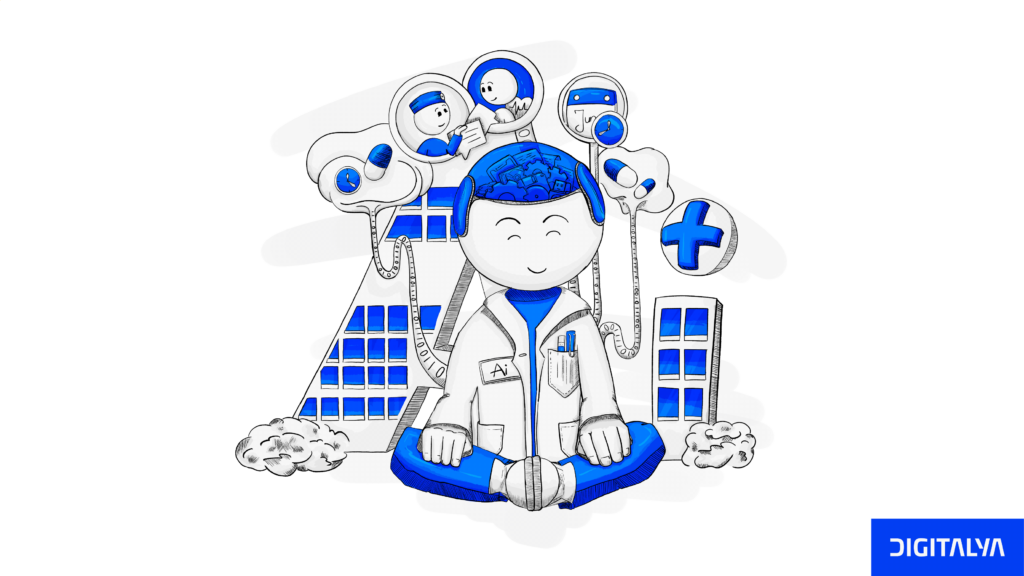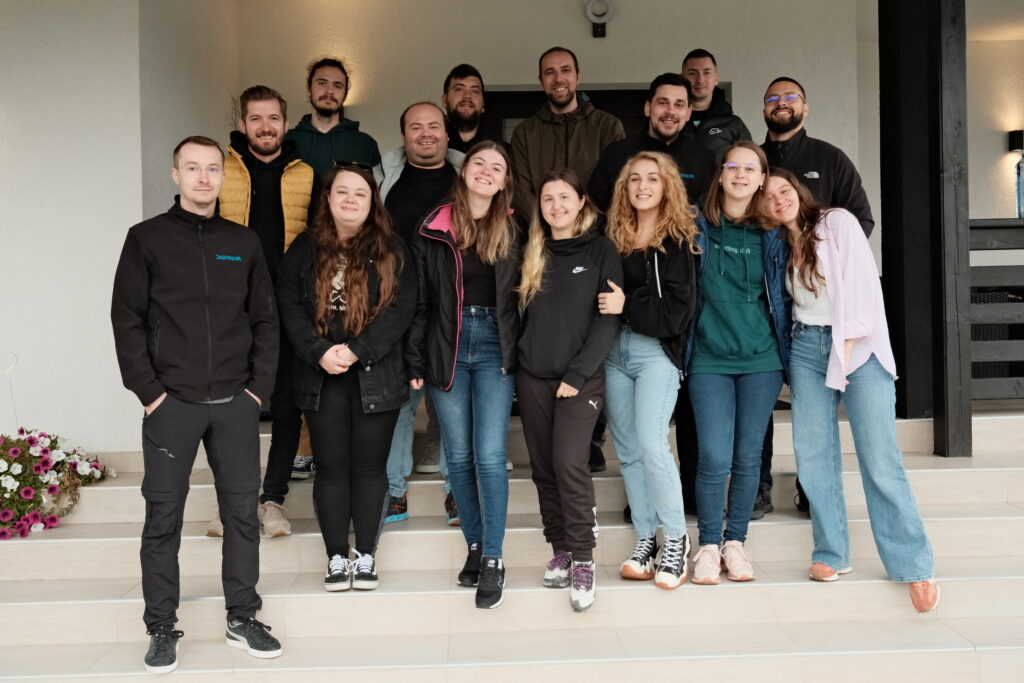1. Introduction
This article aims to equip pharma companies with the tools and insights needed to engage and support HCPs across the omnichannel landscape efficiently. From understanding the unique preferences and challenges of HCPs to implementing tailored strategies that enhance their customer experience, we delve into the essential components of successful omnichannel journey management in the pharmaceutical context.
1.1 Embracing the omnichannel revolution in pharma
Today’s HCPs navigate a diverse information ecosystem, consuming content across online platforms, social media, mobile apps, medical journals, conferences, and more.
This is both a challenge and an opportunity. Reaching HCPs effectively demands a strategic omnichannel approach, seamlessly integrating across these diverse touchpoints to deliver a unified and impactful message.
Embracing the omnichannel model isn’t just about technology. It also means understanding and connecting with HCPs on their terms.
1.2 The HCP’s omnichannel experience — from fragmentation to flow
Imagine stepping into a maze blindfolded, bombarded with information from every direction. That is often the reality for HCPs navigating the modern information landscape.
In the middle of this chaotic environment, pharma companies seek to engage and educate HCPs on their products and services. This is where the concept of omnichannel experiences comes into play.
It’s no longer enough to rely on isolated, singular tactics. To truly connect with HCPs, you need to embrace integrated, seamless experiences across all channels, delivering a cohesive and personalized experience.
What defines omnichannel user experiences?
- Ubiquity — information seamlessly flows across online platforms, social media, journals, and other touchpoints.
- Personalization — content is tailored to individual HCP preferences, needs, and specialties.
- Relevance — messaging aligns with the specific stage of the HCP’s decision-making journey.
- Interactivity — two-way communication is fostered, allowing for engagement and feedback.
- Continuity — brand identity and messaging remain consistent across all channels.
A strong omnichannel experience is crucial primarily because it increases HCP engagement and builds trust — seamless interactions build meaningful customer relationships. Secondly, it improves information accessibility since HCPs can find relevant content through their preferred channel. Thirdly, it enhances brand perception and optimizes marketing ROI.
How can you craft the ideal HCP omnichannel experience?
- Make a customer journey map — understand how HCPs interact with different channels at various decision-making stages.
- Personalize content — leverage data and AI to tailor messages and materials to individual preferences.
- Embrace technologies — utilize platforms and tools for multi-channel communication and data analysis.
- Measure and adapt — track performance across channels and use insights to refine your strategy continuously.
Providing an improved customer experience shouldn’t be just a marketing tactic. It should be a commitment to providing value and understanding to those at the forefront of patient care.
1.3 The imperative for a seamless omnichannel approach
The omnichannel approach isn’t just a technological feat — it’s a shift in the mindset. Why is it imperative?
- Empowered, informed HCPs demand it — some HCPs are tech-savvy and expect a seamless, integrated experience across channels. They navigate diverse sources and expect brands to meet them wherever they are.
- Fragmented attention breeds missed opportunities — siloed communication platforms leave information gaps and hinder engagement. Omnichannel bridges these gaps, ensuring your message reaches HCPs where they consume content.
- Building trust requires consistency — disparate brand representations across channels lead to confusion and erode trust. Omnichannel creates a unified identity, fostering trust and strengthening relationships with HCPs.
- Data-driven decisions drive impact — omnichannel platforms provide comprehensive data across all touchpoints, empowering you to measure what works, optimize campaigns, and maximize ROI.

2. Understanding the HCP’s omnichannel journey
The HCP’s omnichannel journey is a complex web of interactions across various channels, where they seek information, engage with stakeholders, and make decisions. Understanding this customer journey is crucial for pharma companies to reach and connect with these partners efficiently.
The channels HCPs can be engaged through can be divided into two main categories:
| Digital channels | Traditional channels |
| Websites, online portals, mobile app, social media platforms, educational resources, online communities | In-person meetings with medical representatives, conferences, workshops, journals, and other printed materials |
2.1 Navigating the multifaceted needs of HCPs
The world of HCPs is a complex ecosystem where individuals juggle diverse demands and navigate an ever-expanding information landscape. In this dynamic environment, pharma brands face the challenge of effectively meeting the multifaceted needs of HCPs. This required an omnichannel approach tailored to address their unique requirements at every touchpoint.
What are the main needs of HCPs?
- Time constraints — HCPs often face limited time for information gathering and engagement.
- Information overload — they are bombarded with information from various sources, making delivering concise and valuable content crucial.
- Individual preferences — learning styles, preferred channels, and content formats vary significantly across HCPs.
- Specific needs — content relevance is paramount, addressing specific needs based on specialty, practice setting, and patient population.
- The desire for continuous learning — HCPs strive to stay updated with the latest advancements in their field.
Navigating these needs requires a nuanced approach considering various factors, such as professional responsibilities, patient care requirements, personal preferences, and technological advancements. Let’s discuss some strategies to achieve this:
- Understanding their roles and responsibilities — recognize the diverse roles HCPs play within the healthcare system, whether they are physicians, nurses, pharmacists, or allied health professionals. Understand the specific challenges they face daily and tailor solutions accordingly.
- Building relationships — this involves effective communication, active listening, and a genuine interest in understanding their needs. Regular interactions through meetings, conferences, and educational events can help foster collaboration and trust.
- Providing relevant education and resources — HCPs require access to up-to-date clinical information, guidelines, and educational resources to stay informed and deliver high-quality care. Providing easy access to relevant materials through digital platforms, continuing education programs, and peer-reviewed journals can support their professional development.
- Supporting workflow efficiency — streamlining administrative tasks and integrating technology solutions can help HCPs optimize their workflows and focus more on patient care. EHRs, telemedicine platforms, and decision support tools are examples of technologies that can enhance efficiency and productivity.
- Addressing burnout and well-being — HCPs often face high levels of stress and burnout due to demanding work environments and long hours. Organizations should prioritize initiatives to promote work-life balance, mental health support, and resilience training to ensure the well-being of their workforce.
- Incorporating feedback — actively seek feedback from HCPs to understand their evolving needs and preferences. Regular surveys, focus groups, and advisory panels can provide valuable marketing insights for refining products, services, and processes to meet their expectations better.
- Adapting to technological advancements — embrace digital innovations that can enhance patient care delivery and support HCPs in their practice. This includes leveraging AI, remote monitoring tools, and mobile health apps to facilitate communication, diagnosis, and treatments.
- Promoting interdisciplinary collaboration — encourage collaboration among different healthcare disciplines to promote holistic patient care and address complex medical issues.
2.2 Identifying key touchpoints across the HCP journey
The HCP journey in the pharma landscape is no longer a linear path. Today, it’s a dynamic web of touchpoints across online and offline channels where HCPs engage with information, colleagues, and brands. Identifying these key touchpoints is crucial for crafting an effective omnichannel marketing strategy that resonates with HCPs and drives positive outcomes.
What are the key customer touchpoints to take into consideration?
| Digital | Traditional | ||
| Websites | Company websites offering product information, clinical data, educational resources | Medical conferences and events | Opportunities for in-person interaction, product demonstrations, and networking with peers and industry |
| Mobile apps | Apps for clinical reference, drug interaction checks, or patient communication | Peer-to-peer interactions | Discussions or consultations with colleagues can significantly influence HCP decisions |
| Social media | Platforms for thought leadership, scientific content sharing, and engagement with HCP communities | Medical journals and publications | Traditional sources for research findings, clinical data, and expert opinions |
| Online communities | Forums or discussion groups for peer-to-peer learning and information exchange | In-person meetings with medical representatives | Personalized interaction to address specific questions, provide detailed product information, and build relationships |
| Email marketing | Targeted communication with personalized content, educational materials, and event invitations |
What can you do to optimize these touchpoints for better impact?
You could start by ensuring that your content is relevant, personalized for each touchpoint, and aligned with the specific stages of the customer journey, addressing their information needs. Additionally, you should provide a consistent and unified brand experience across all touchpoints, from web design to messaging and visual identity.
Furthermore, tracking engagement and analyzing data at each customer touchpoint can help you identify what resonates with HCPs and continuously improve your strategy.
Doing this can help you in several ways. First of all, you deliver targeted information at the right time and through the preferred channel. Secondly, you personalize your approach to foster meaningful connections and build trust with HCPs. Also, you are empowered to optimize your strategy for maximum impact and drive positive health outcomes.
2.3 Understanding HCP preferences and behaviors
Understanding healthcare professionals’ ever-evolving preferences and behaviors within their omnichannel journeys is the cornerstone of effective pharmaceutical marketing.
What factors influence HCP preferences and behaviors?
- Speciality and practice setting — physicians in different specialties have distinct information needs and preferences. Additionally, practice settings, like hospitals, clinics, or private practices, can impact technology use and communication channels.
- Generation and tech-savviness — age demographics influence the adoption of digital tools and the preferred modes of communication.
- Individual learning styles — some HCPs prefer visual content, while others favor text-based materials or interactive learning experiences.
- Level of engagement — certain physicians are active information seekers, while others remain passive and receptive.
- Information overwhelm — with the constant information influx, HCPs value concise, evidence-based content they can quickly digest and implement.
How can you leverage this to improve your omnichannel strategies?
- Data-driven segmentation — identify HCP groups based on specialties, behaviors, preferences, and tech-savviness.
- Tailored content — personalize content, messaging, and formats to align with individual HCP preferences and decision-making stages.
- Channel integration — offer a seamless flow of information across digital platforms, virtual engagement tools, and traditional channels.
- Interactive elements — incorporate webinars, online communities, and Q&A opportunities to foster two-way communication.
- Leverage AI-driven recommendations — utilize intelligent recommendation engines to deliver relevant content and resources to HCPs based on their browsing behavior and interests.
- Continuous measurement and optimization — track engagement metrics across channels. Adopt your strategy based on data-driven insights for continuous improvement.
What you should take away from this is that understanding HCP preferences and behaviors in the omnichannel landscape isn’t a one-time exercise. It requires ongoing research, data analysis, and a commitment to tailoring your approach.
This can help you deliver increased value to HCPs with relevant and personalized communication. Through this, you will foster stronger relationships and build trust with HCPs. And, in the long run, you will drive informed decision-making that will positively impact patient care.

3. Defining a comprehensive omnichannel strategy
A comprehensive omnichannel strategy is one that allows you to seamlessly connect with HCPs across a diverse range of touchpoints, fostering meaningful interactions and, ultimately, delivering superior patient outcomes.
3.1 Setting clear objectives and goals for HCP engagement
A comprehensive omnichannel strategy hinges on clear objectives and measurable goals for HCP engagement. These serve as a roadmap, guiding your efforts and enabling you to track progress and optimize your approach.
Here is a framework for setting clear objectives and goals:
- Define your overall goal
Start with the big picture. What is your overarching objective for customer engagement?
Examples:
- Increase brand awareness for a new product.
- Drive adoption for a specific treatment option.
- Educate HCPs on a new area of research or clinical data.
- Identify SMART objectives
Translate your overall goal into specific, measurable, achievable, relevant, and time-bound objectives. These should be actionable and directly contribute to achieving your overarching goal.
Examples:
- Increase website traffic from HCPs by 20% within the next quarter.
- Elevate brand awareness among oncologists by 15% within six months, as measured by brand recall surveys.
- Increase participation in upcoming webinars by 30% compared to previous events.
- Set measurable goals for each channel
Break down your objectives into specific, measurable goals for each channel in your omnichannel strategy.
Examples:
- For social media: increase customer engagement with HCP-targeted content by 10% within the next month.
- For email marketing: achieve a 25% open rate and a 5% click-through rate for the next HCP email campaign.
- For in-person events: secure participation from at least 100 HCPs in the upcoming regional conference.
- Align goals with KPIs
Identify KPIs for each of your goals. Key performance indicators are quantifiable metrics to help you track progress and measure success.
Examples:
- Website traffic from HCPs
- Downloads of educational resources
- Webinar registrations and attendance
- Survey responses
- Sales team interactions with HCPs
- Conversion rates
- Continuously monitor and adapt
You should regularly monitor your progress toward your goals and objectives by analyzing data from your KPIs and adjust your strategy as needed.
It’s important to be willing to adapt your approach based on what is working and what is not. This may mean reallocating resources, refining content, or experimenting with different tactics across your channels.
By having clear objectives and goals, you can ensure that your omnichannel strategy is not just an exercise in communication, but a strategic investment in driving meaningful engagement with HCPs and, ultimately, improving patient care.
3.2 Mapping the omnichannel customer journey for HCPs
Mapping the omnichannel customer journey for healthcare providers involves identifying key touchpoints and interactions across various channels throughout their engagement with pharma products and services. Understanding this is crucial for pharma brands to reach and connect with these crucial partners efficiently.
Let’s go through a framework for omnichannel customer journey mapping:
- Define HCP journey stages & identify touchpoints
- Awareness — HCPs become aware of a condition, new treatment options, or emerging research.
Key touchpoints:
- Digital: online articles, social media, news outlets, healthcare websites, educational resources.
- Traditional: conferences, medical journals, peer-to-peer discussions.
- Consideration — physicians delve deeper, researching the solution, and asses the solution’s benefits, safety profile, and clinical evidence.
Key touchpoints:
- Digital: pharma company websites, medical databases, clinical trial data, online communities, online forums.
- Traditional: medical journals, peer-to-peer consultations, conferences, and presentations by medical representatives.
- Decision-making — this stage involves interaction with various touchpoints. HCPs evaluate different options and their suitability for their specific patient population.
Key touchpoints:
- Digital: webinars, online communities, Q&A sessions, email communication with medical representatives.
- Traditional: in-person meetings with medical representatives, conferences, workshops, consultations with specialists.
- Adoption and adherence — once a decision is made, HCPs integrate the solution into their practice. This stage also involves ensuring patient adherence through educational materials or patient support programs.
Key touchpoints:
- Digital: online training modules, mobile reference apps, patient support platforms, email communication.
- Traditional: ongoing in-person support from medical representatives, patient education materials, and printed reference guides.
- Visualize the journey
Use a visual representation like a flowchart or journey map to depict the HCP’s journey across stages, touchpoints, and preferred communication channels. This will help you identify potential gaps or areas for improvement in your omnichannel strategy.
How does mapping the journey help you?
- Identify key opportunities for engagement — understand where and how best to reach HCPs at each stage of their decision-making process.
- Personalize your approach — tailor content, communication, and support based on individual HCP preferences and needs.
- Optimize your omnichannel strategy — ensure a seamless and cohesive experience across all touchpoints, fostering deeper connections with HCPs.
- Improve patient care outcomes — by empowering HCPs with relevant information and resources, you contribute to informed decision-making and, ultimately, better patient care.
3.3 Leveraging technology to enhance HCP interactions
Technology, when strategically leveraged, can be a powerful tool to enhance interactions and strengthen connections throughout the HCP’s omnichannel journeys.
Here are some key ways to utilize technology for impactful HCP interactions:
- Personalized content delivery
- Leverage artificial intelligence and machine learning — analyze HCP data, including past interactions, preferences, and specialties, to tailor content delivery. Recommend relevant articles, webinars, and resources specific to individual needs.
- Dynamic content creation — use AI-powered tools to personalize content in real-time based on HCP interactions and ongoing conversations, ensuring maximum relevance and omnichannel customer engagement.
- Interactive learning experiences
- Develop engaging webinars and virtual events — use interactive features like polls, Q&A sessions, and live chat functionalities to promote active participation and knowledge retention.
- Gamification — incorporate gamification elements into online training modules and educational resources to enhance engagement and make learning more enjoyable.
- Seamless omnichannel communication
- CRM platforms — integrate data from various touchpoints (website visits, in-person meetings, email interactions) to create a unified view of each HCP and personalize communication across channels.
- Mobile-first approach — ensure all content and communication platforms are optimized for mobile devices, catering to HCPs on the go.
- AI-powered chatbots and virtual assistants
- Implement AI chatbots — provide HCPs with 24/7 access to basic information, answer frequently asked questions, and schedule appointments with medical representatives.
- Develop virtual assistants — offer HCPs personalized support, answer complex inquiries, and facilitate ongoing communication and engagement.
Beyond these specific technologies, you should also consider the following:
- Robust data security — ensure all HCP data is collected, stored, and used in accordance with ethical and regulatory guidelines.
- Focus on user experience — design technology solutions that are user-friendly, intuitive, and add value to the HCP experience.
- Embrace a culture of continuous improvement — regularly evaluate the effectiveness of technology-driven approaches and adapt to optimize your omnichannel strategy based on ongoing data and feedback.

4. Integrating online and offline channels for HCPs
Seamlessly connecting online and offline channels helps create a unified HCP experience that builds trust and promotes better customer retention.
There are many benefits to integrating online and offline channels. You create a cohesive journey across touchpoints, fostering trust and recognition, thus enhancing the HCP experience. Also, you give HCPs the flexibility to access information and interact through their preferred channels while using targeted messaging and content delivery for personalized communication.
What are some strategies for this integration?
- Content consistency
- Maintain a unified brand message and visual identity across all touchpoints — this includes websites, landing pages, social media platforms, marketing materials, and in-person meetings.
- Develop an editorial calendar — plan and curate content that aligns with HCP needs at different stages of the decision-making journey, ensuring consistency across all channels.
- Offline-to-online activation
- Capture leads at events — you can use lead capture forms at conferences or industry events to connect with HCPs online and follow up with targeted email campaigns and personalized content.
- Offer online resources after in-person meetings — provide HCPs with access to detailed product information, clinical data, or case studies via a dedicated online portal after face-to-face interactions with medical representatives.
- Online-to-offline activation
- Use QR codes on print materials — direct HCPs to relevant online resources, website landing pages, or downloadable content.
- Promote social media engagement during live events — encourage HCPs to follow your social media channels or engage in online discussions using specific event hashtags.
- Leverage technology
- Use mobile apps — provide access to product information, prescribing guidelines, drug interaction tools, and continuing medical education opportunities.
- Interactive website features — chatbots or virtual assistants on your website provide HCPs with real-time support and answer basic queries before connecting with medical representatives.
4.1 Seamless transitions between digital and traditional channels
Creating seamless digital-traditional transitions is the key to elevated HCP experiences. This requires a well-coordinated effort between sales, marketing, and technology teams.
Here are some tricks to help you achieve this:
- Centralized data hub
- Customer relationship management (CRM) systems — consolidate information from all HCP interactions (website visits, webinar participation, email engagement, in-person meetings, etc).
- Personalized communication that carries over
- Tailored email campaigns — nurture leads generated online through targeted email campaigns that acknowledge previous digital interactions and address specific pain points or interests the HCP expresses.
- Informed in-person meetings — arm medical representatives with insights from HCPs’ online engagement. This will allow them to tailor in-person interactions with relevant information and build deeper connections.
- Use technology as the bridge
- QR codes — integrating QR codes into traditional marketing materials will allow HCPs to access additional digital content or resources instantly.
- CTA buttons on webinars — encourage HCPs participating in online webinars to follow up with medical representatives or schedule in-person meetings via on-screen CTAs.
- Mobile apps — mobile apps with integrated features allow HCPs to order samples, access drug information and resources, or connect with medical reps both in-person and online.
- HCP-centric content strategy
- Repurpose content across channels — create core content assets (research findings, educational materials) that can be adapted and delivered across both digital and traditional formats.
- Cross-promote content — reference digital resources during in-person events; promote in-person webinars on your website and online channels. This builds awareness of resources across all channels.
- Measuring success and iterating
- Track channel attribution — develop tracking mechanisms to understand how HCPs move between digital and traditional channels and which paths typically lead to conversions.
- Analyze data for bottlenecks — identify common points of friction or drop-off in the HCP journey and work to eliminate them, optimizing the transition process.

5. Enhancing engagement and education for HCPs
Actively engaging and educating HCPs fosters informed decision-making, drives the adoption of best practices, and, ultimately, contributes to improved patient care outcomes.
As we’ve mentioned before, content is king. But it’s very important how your content is curated. First of all, you should develop diverse and evidence-based content. By doing this, you can cater to various learning styles and needs with infographics, videos, podcasts, interactive modules, and downloadable resources.
Moving forward, another important point is personalizing content delivery. Use customer data and insights to tailor content and learning experiences based on HCP specialties, interests, and engagement history. However, always prioritize scientific accuracy and credibility and adhere to industry guidelines.
Another thing you can do is leverage technology. Develop engaging online platforms to deliver educational content in user-friendly formats.
You can also use social media strategically by sharing thought leadership content, engaging in scientific discussions, and fostering peer-to-peer learning.
Furthermore, you can explore virtual and hybrid learning. Use webinars, online simulations, or hybrid events to provide engaging educational opportunities accessible from various locations.
However, you should never neglect ethical considerations. Make sure that all educational activities comply with industry regulations and ethical guidelines to maintain trust and transparency.
Don’t forget to recognize and celebrate the achievements of HCPs and the positive impact they have on patient care to foster a sense of community and belonging.
5.1 Personalized content and recommendations
Take the time to tailor content and recommendations based on individual needs and preferences. You can deliver relevant, valuable information that will empower HCPs to make informed decisions and improve patient care outcomes in the long run.
What are some strategies you can use?
- Content curation — recommend relevant articles, webinars, and other resources based on HCP specialties, recent interactions, and expressed interests.
- Dynamic content delivery — use artificial intelligence and machine learning to personalize content in real-time, adjusting information based on ongoing interactions and evolving needs.
- Tailored communications — craft personalized communication based on HCP preferences (email, phone calls, social media), ensuring relevance and avoiding information overload.
- Recommendation algorithms — use them to suggest relevant resources based on HCP data, content engagement patterns, and industry trends.
- Integrate with clinical decision support systems (CDSS) — partner with CDSS providers to integrate personalized recommendations and educational resources directly into the HCP workflow.
5.2 Interactive learning tools and resources
It’s time to leave behind traditional lectures, go beyond static presentations, and embrace interactive elements. You could use case studies to present real-world scenarios for HCPs to analyze and apply their knowledge. Simulations can provide a safe environment to practice decision-making and hone clinical skills, and interactive quizzes and games are a gateway for gamification.
Don’t neglect the advantages of virtual reality and augmented reality to create realistic simulations and enhance the learning experience.
Even online communities and forums will foster peer-to-peer learning by establishing a place where HCPs can share knowledge, ask questions, and engage in discussions.
However, interactive learning tools are not a replacement for comprehensive training programs. They are most effective when used as complementary resources to enhance understanding, support skill development, and reinforce knowledge acquired through other learning methods.
6. Measuring and optimizing omnichannel performance
Measuring and optimizing your omnichannel performance is crucial if you want to maximize engagement with HCPs and drive impactful insights. By analyzing data across various channels, you can gain valuable insights into HCP behavior, optimize your strategies, and, ultimately, improve patient care outcomes.
6.1 Defining key performance indicators for HCP engagement
We previously discussed setting goals for each channel and aligning them with your KPIs. Defining effective key performance indicators for HCP engagement requires considering various aspects of their interaction with your brand across different channels.
Let’s go through the three main areas for KPIs and examples for each one:
- Awareness and Reach
- Website traffic — tracks the number of unique HCPs visiting your website, indicating brand awareness and interest in accessing information.
- Social media reach — measures the number of HCPs exposed to your content on social media platforms, reflecting brand visibility and online community engagement.
- Email open rates and click-through rates — evaluates the effectiveness of email marketing campaigns in reaching HCP inboxes and prompting them to interact with your content.
- Webinar registrations and attendance — measures the level of interest HCPs have in attending live or on-demand educational sessions offered by your brand.
- Engagement and interaction
- Time spent on website — indicates the level of interest and depth of engagement HCPs exhibit with your website content.
- Content downloads — tracks the number of resources downloaded by HCPs, reflecting their interest in specific topics and willingness to engage further.
- Social media engagement — measures interactions like likes, comments, and shares on your social media content, signifying active participation and discussion within the online community.
- Completion rates for online modules or webinars — indicates the level of commitment HCPs show towards consuming your educational resources and completing learning activities.
- Conversion and action
- Leads generated — tracks the number of HCPs expressing interest in your products or services through contact forms, email inquiries, or requesting additional information.
- Meeting requests — measures the volume of HCPs requesting face-to-face interactions with medical representatives, indicating a strong level of interest and potential for deeper engagement.
- Product prescription rates or adoption — tracks the actual use of your products or services by HCPs, reflecting the ultimate impact of your engagement efforts on patient care.
- Net promoter score (NPS) — measures HCPs’ willingness to recommend your brand or product to their peers, indicating brand loyalty and advocacy.
How do you select the right KPIs?
You should select KPIs that directly measure the effectiveness of your specific goals and initiatives. Also, you should track different metrics at various stages, such as awareness metrics at the beginning and conversion metrics later in the process.
6.2 Analyzing data and insights to identify trends
Complement quantitative data with qualitative research like surveys, interviews, and focus groups to gather valuable insights into HCP motivations, preferences, and feedback.
Another thing you can do is compare your KPIs against industry benchmarks or internal historical data to identify areas for improvement and track progress over time.
To identify relevant trends, you should focus on specific KPIs and look for temporal patterns. Identify seasonal variations, changes in customer behavior after specific campaigns, or long-term shifts in preferred channels and then analyze data segmented by HCP demographics, specialties, or engagement levels.
You can also use statistical tests to assess the significance of observed trends and identify statistically relevant relationships between variables. After this, the next step is using predictive analytics, like machine learning, to predict future trends, anticipate HCP needs, and personalize engagement strategies accordingly.
Go beyond numbers and translate the observed trends into actionable insights by understanding the “why” behind the data.
7. Conclusion
Building strong and sustainable relationships with HCPs is not a one-time effort but an ongoing process of understanding, meeting, and exceeding the needs of healthcare professionals.
By implementing successful omnichannel strategies, embracing data-driven decision-making, and continuously adapting to evolving landscapes, you can build strong and sustainable relationships with HCPs.
This fosters a collaborative environment where valuable knowledge is shared, patient care is optimized, and, ultimately, the healthcare ecosystem thrives.
Successful HCP engagement goes beyond awareness and information. It cultivates trust, collaboration, and contributes to improved patient outcomes.






